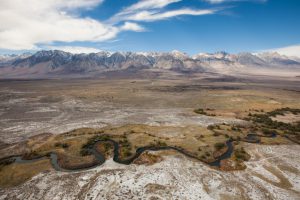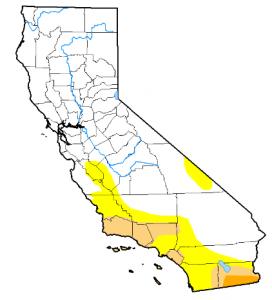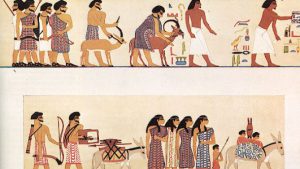Today’s post comes from Julian Ireland, Oberlin Class of 2019 and Art Center Docent.
A recent exhibition that visitors to the Loeb often miss (yes, there is a gallery on the second floor) is Garry Winogrand’s Beautiful Women
Tag Archives: Vassar College
Fading from Memory: Mesoamerica to New York City
Today’s blog post comes from Curtis Eckley, Class of 2019 and Art Center Student Docent.
Last week’s Late Night at the Loeb saw the surfacing of some of the Loeb’s more elusive yet fascinating works from the collection through a faculty talk given by Professor of Anthropology and Latin American & Latinx Studies David Tavárez on Mesoamerican artifacts, and a following Art Talk given by Zoe Lemelson ’17 on contemporary photographer, Doug Rickard
Los Angeles Water System
Many cities in California don’t use water sources from where they’re located, but instead pull resources from different regions. This is truer for Los Angeles than most cities. With its large population, location near saltwater, and drought conditions, Los Angeles relies on fresh water from miles away. LA’s use of outside water sources not only puts people out of their homes, but also takes water from outside areas. Through the study of where water is from and how it changes the landscape, we can further ask the question if it is alright to take water from outside sources to fuel a city.
The original aqueduct built to sustain Los Angeles was the Zanja Madre, in 1781 on the L.A. River. In the 1800s, Judge William Dryden was hired to build a more elaborate water system in the middle of the Los Angeles Plaza. Dryden then became the head of the Los Angeles Water Works Co. and after his water system flooded, the water company got passed on to another private owner, and then eventually to city ownership in 1902 as the L.A. Water Department.
The Los Angeles Aqueduct project began in 1905 and was completed in 1913 diverting the Owens River into a canal that flows into the the Lower San Fernando Reservoir. This effectively destroyed Owens Valley, which was a prospering farming community. The ownership of this land was made through deceptive moves and insider information, which eventually led to the California Water Wars. The water that was being taken from Owens Valley was being fed into Los Angeles and the San Fernando Valley, but none was saved for the people living in Owens Valley.
Currently, Los Angeles gets water from San Joaquin-Sacramento River Delta, Colorado River, Eastern Sierra snow melt, local groundwater, and desalination. The only somewhat local resources are local groundwater and desalination. The sad part is that these supply the least amount of water to Los Angeles even though they are the closest to Los Angeles. Snow pack and the San Joaquin-Sacramento River Delta provides nearly 95% of the water to southern California. The issue is taking water from other places. Other states are affected due to California’s use of the Colorado River and extreme reliance on the Sierra Nevada Mountains.
With Los Angeles’ continual population growth more water is being funneled hundreds of miles to reach the metropolitan area. Luckily for Californians, most of California is out of the drought or in less severe drought levels, but that doesn’t mean they need to stop conserving. As someone from San Diego, we need to keep up initiatives to reduce water consumption and look for alternative water sources. Desalination is becoming an option, but still uses too many resources and money to be viable. If people want to continue consuming large quantities of water, the best answer might be to move out of desert and temperate climates.
Further Readings: http://waterandpower.org/museum/Water_in_Early_Los_Angeles.html, http://www.cadrought.com/southern-california-gets-water/
Sources: http://droughtmonitor.unl.edu/Home.aspx, http://www.owensvalleyhistory.com/, http://www.history.com/topics/los-angeles-aqueduct
Image Sources: http://droughtmonitor.unl.edu/Home/StateDroughtMonitor.aspx?, CAhttp://a.scpr.org/i/9dd3c84ad1a3286fb9d46206d4fa4acb/70909-full.jpg
The Archaeology of Slavery
Slavery has, unfortunately been a prevalent theme in most societies throughout all of history. When the average person in the United States thinks about slavery, they think of colonialism, African slave trade, plantations, and the Civil War, when Abraham Lincoln finally put an end to the madness. But slavery has happened so many times before, is happening today, and will happen again in the future. It is not merely a laps in moral judgment that happened during a specific time, like from the birth of the US to the Civil War, or while the Egyptians built the pyramids. The exploitation of slave labor is consistent part of humanity and should be treated as such.
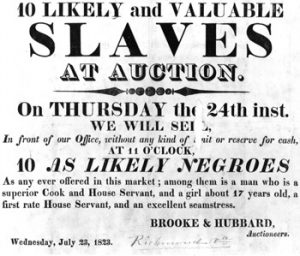
Many documents are valuable for the identification and study of slavery in the United States. These should be used along with archaeological methods for a thorough investigation.
Up until the adoption of the post-processual approach to archaeology, any notice of slavery was done through historical written record. It was believed to be the only way of seeing slavery, that there was no way to know that slaves existed unless you knew they were there. Ropes deteriorated over time, and chains were often repurposed. But there are many ways of identifying the presence of slavery in the archaeological record. The places slaves lived, especially on plantations in the United States, were generally smaller and separated from the remainder of the house. It is often hard to tell if these quarters were for slaves, free blacks, or white servants. Sometimes with slaves, more effort was put into hiding their existence, and the house’s reliance on slave labor. Screens could be put up, or very elaborate alternative ways of navigating spaces, like different stairs etc. However, given such detailed and well-recorded accounts of slavery in the US, it seems counterproductive to not rely on both documentary and archaeological sources. But what about the places that have fewer or no written records? In ancient societies, slaves were taken from the defeat or sacking of other societies. The men were killed, and women and children were taken to be sold into slavery. This led to the idea that if more women were found on the archaeological record, then slavery was present in the society. Slaves are also depicted in frescos and paintings as smaller than other people in the picture.
Once slavery is “discovered” then what, and does it even need to be discovered? We know that 1 in 3 people in Italy during the Roman Empire were slaves and that they were integral to society. There are over 20 million people in slavery today. Nothing has changed. At this point, do we need to identify slavery? Or can we just “assume access to coerced labor… in the same way access to drinking water is assumed.” Some archaeologists want to shift the focus of the archaeology of slavery to the study of its effects and consequences, instead of merely whether or not it existed. These invisible demographics throughout history, like slaves, homeless people and migrants, can provide insights into the present and ways to tackle these issues right now.
Sources:
- Cameron, Catherine M., et al. The Archaeology of Slavery: A Comparative Approach to Captivity and Coercion. No. 41. SIU Press, 2014.
- Singleton, Theresa A. The archaeology of slavery and plantation life. Routledge, 2016.
- Mark Cartwright. “Slavery in the Roman World,” Ancient History Encyclopedia. Last modified November 01, 2013. http://www.ancient.eu /article/629/.
- Ian Muir-Cochrane, Are there really 21 million slaves worldwide?http://www.bbc.com/news/magazine-26513804
Image Sources
- http://www.history.com/news/5-things-you-may-not-know-about-lincoln-slavery-and-emancipation
- http://www.haaretz.com/jewish/archaeology/1.713849
Further reading:
- https://cliojournal.wikispaces.com/Slavery+in+Ancient+Greece
- https://www.antislavery.org/slavery-today/modern-slavery/
Made Invisible? Archaeology and Social Treatment of People with Physical Disabilities
While on the campaign trail, Donald Trump seemed to mock the appearance of a New York Times reporter during a press conference. In an opinion piece for the New York Times, Melissa Blake, who states that she is “physically disabled,” responds to Trump’s “bullying” by writing of her fear “of living in a country that would shun people with disabilities as if they didn’t exist.” Blake concludes her article with her “mantra” of “I am a person. I matter […] I will never stop fighting for our rights and against bullies.” Yet is it not the government’s responsibility to protect its citizens from feeling discriminated against? What role should society play in equal protection?
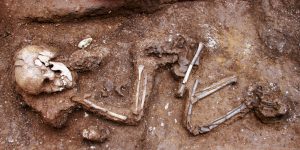
The curled position of this skeleton from the Man Bac burial in Vietnam, relative to the surrounding straight graves, suggests a physical disability
Turning to the archaeological record can reveal how cultures and other societies treated their members who had physical disabilities. First, according to the Americans with Disabilities Act, the term “disability” legally refers to “a physical or mental impairment that substantially limits one or more major life activities, a record of such an impairment, or being regarded as having such an impairment.” Therefore, the term “disability” should always be evaluated within a cultural context. As William Southwell-Wright describes in his paper “What Can Archaeology Offer Disability Studies,” “decoupling the physical fact of impairment” from the “socially constructed nature of reactions to it in the form of disability” can help evaluate how different societies treat people with “disabilities.”
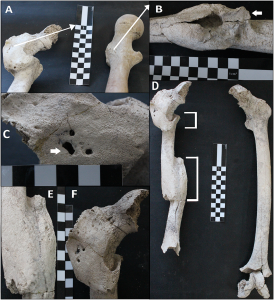
These skeletal remains reveal severe physical trauma, providing evidence that the man had a physical disability
One example of a skeleton showing signs of a physical disability was discovered at the Man Bac burial ground in Vietnam by Dr. Marc Oxenham of Australian National University in Canberra. Dr. Oxenham concluded that the curled skeleton was that of a young man who had been paralyzed from the waist down before adolescence, and therefore would have been dependent on care from his community for survival. Another example from the International Journal of Osteoarchaeology describes the skeletal remains of a man from Gran Quivira Pueblo, New Mexico whose bones’ musculoskeletal stress markers suggest a need for “complete dependence upon others during the progression of a debilitating disease.” The journal goes on to state that “although compassion cannot always be determined from the skeletal record alone, the severity of his condition suggests that he was wholly dependent on at least one other member of the group over a long period of time.”
As one archaeologist working on the Man Bac site stated, “the provision and receipt of health care may […] reflect some of the most fundamental aspects of a culture.” Additionally, “not only does [the Man Bac man’s] care indicate tolerance and cooperation in his culture, but suggests that he himself had a sense of his own worth and a strong will to live.” Although “compassion cannot always be determined from the skeletal record alone,” modern America should similarly support and care for all of its society. No individual or group should be made to feel “as if they didn’t exist,” and all should be imbued with a strong sense of worth.
Sources
http://onlinelibrary.wiley.com/doi/10.1002/(SICI)1099-1212(1998090)8:5%3C326::AID-OA437%3E3.0.CO;2-W/full
http://link.springer.com/chapter/10.1057/9781137371973_4
Images
http://onlinelibrary.wiley.com/doi/10.1002/oa.2588/full
Further Reading
https://books.google.com/books?id=QVV1CgAAQBAJ&pg=PA50&lpg=PA50&dq=archaeology+of+disability&source=bl&ots=TsEtdj8L-r&sig=krSP9mR3a8jaqTnMUoEXxEg0OPE&hl=en&sa=X&ved=0ahUKEwi5iZKko7vTAhUBOCYKHYeoCrkQ6AEIZDAL#v=onepage&q=archaeology%20of%20disability&f=false
The Disability Rights Movement: From Charity to Confrontation, 2011. Fleischer and Zames

